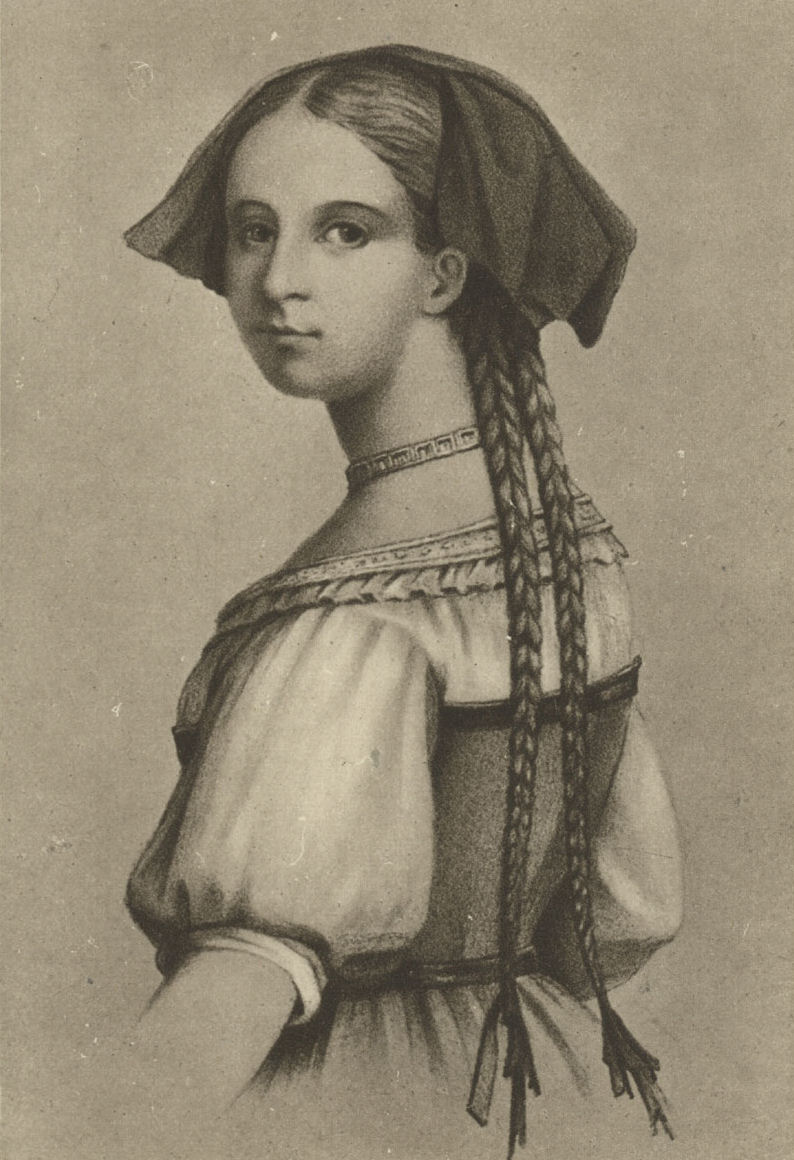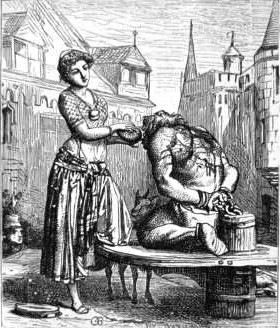|
Gustave Brion
Gustave Brion (1824–1877) was a French painter and illustrator. He was born at Rothau in the department of Bas-Rhin on 24 October 1824. In 1841, in Strasbourg, he entered the studio of Gabriel Guérin, with whom he remained three years; he also received tuition from Andreas Friedrich, the sculptor; but he soon afterwards went to Paris, where his first work appeared at the Salon in 1847; it was entitled ''Interior of a Farm at Dambach''. Six years later he gained a medal of the second class for his 'Schlitteurs de la Foret-Noire' and the ''Potato Harvest during an Inundation'', the former of which was subsequently burned at Strassburg by the Prussians. His fame was further established by his ''Le Train de Bois sur le Rhin'' in 1855, and from that time his works continued to increase in public favour, and gained considerable praise and recompense for their author. Brion received numerous medals in 1853, 1863, 1867, 1868, &c., and the decoration of the Legion of Honour in 1 ... [...More Info...] [...Related Items...] OR: [Wikipedia] [Google] [Baidu] |
Gustave Brion
Gustave Brion (1824–1877) was a French painter and illustrator. He was born at Rothau in the department of Bas-Rhin on 24 October 1824. In 1841, in Strasbourg, he entered the studio of Gabriel Guérin, with whom he remained three years; he also received tuition from Andreas Friedrich, the sculptor; but he soon afterwards went to Paris, where his first work appeared at the Salon in 1847; it was entitled ''Interior of a Farm at Dambach''. Six years later he gained a medal of the second class for his 'Schlitteurs de la Foret-Noire' and the ''Potato Harvest during an Inundation'', the former of which was subsequently burned at Strassburg by the Prussians. His fame was further established by his ''Le Train de Bois sur le Rhin'' in 1855, and from that time his works continued to increase in public favour, and gained considerable praise and recompense for their author. Brion received numerous medals in 1853, 1863, 1867, 1868, &c., and the decoration of the Legion of Honour in 1 ... [...More Info...] [...Related Items...] OR: [Wikipedia] [Google] [Baidu] |
Alsace
Alsace (, ; ; Low Alemannic German/ gsw-FR, Elsàss ; german: Elsass ; la, Alsatia) is a cultural region and a territorial collectivity in eastern France, on the west bank of the upper Rhine next to Germany and Switzerland. In 2020, it had a population of 1,898,533. Alsatian culture is characterized by a blend of Germanic and French influences. Until 1871, Alsace included the area now known as the Territoire de Belfort, which formed its southernmost part. From 1982 to 2016, Alsace was the smallest administrative ''région'' in metropolitan France, consisting of the Bas-Rhin and Haut-Rhin departments. Territorial reform passed by the French Parliament in 2014 resulted in the merger of the Alsace administrative region with Champagne-Ardenne and Lorraine to form Grand Est. On 1 January 2021, the departments of Bas-Rhin and Haut-Rhin merged into the new European Collectivity of Alsace but remained part of the region Grand Est. Alsatian is an Alemannic dialect closely related ... [...More Info...] [...Related Items...] OR: [Wikipedia] [Google] [Baidu] |
1877 Deaths
Events January–March * January 1 – Queen Victoria is proclaimed ''Empress of India'' by the ''Royal Titles Act 1876'', introduced by Benjamin Disraeli, the Prime Minister of the United Kingdom . * January 8 – Great Sioux War of 1876 – Battle of Wolf Mountain: Crazy Horse and his warriors fight their last battle with the United States Cavalry in Montana. * January 20 – The Conference of Constantinople ends, with Ottoman Turkey rejecting proposals of internal reform and Balkan provisions. * January 29 – The Satsuma Rebellion, a revolt of disaffected samurai in Japan, breaks out against the new imperial government; it lasts until September, when it is crushed by a professionally led army of draftees. * February 17 – Major General Charles George Gordon of the British Army is appointed Governor-General of the Sudan. * March – ''The Nineteenth Century'' magazine is founded in London. * March 2 – Compromise of 1877: ... [...More Info...] [...Related Items...] OR: [Wikipedia] [Google] [Baidu] |
1824 Births
Eighteen or 18 may refer to: * 18 (number), the natural number following 17 and preceding 19 * one of the years 18 BC, AD 18, 1918, 2018 Film, television and entertainment * ''18'' (film), a 1993 Taiwanese experimental film based on the short story ''God's Dice'' * ''Eighteen'' (film), a 2005 Canadian dramatic feature film * 18 (British Board of Film Classification), a film rating in the United Kingdom, also used in Ireland by the Irish Film Classification Office * 18 (''Dragon Ball''), a character in the ''Dragon Ball'' franchise * "Eighteen", a 2006 episode of the animated television series ''12 oz. Mouse'' Music Albums * ''18'' (Moby album), 2002 * ''18'' (Nana Kitade album), 2005 * '' 18...'', 2009 debut album by G.E.M. Songs * "18" (5 Seconds of Summer song), from their 2014 eponymous debut album * "18" (One Direction song), from their 2014 studio album ''Four'' * "18", by Anarbor from their 2013 studio album '' Burnout'' * "I'm Eighteen", by Alice Cooper commonly ... [...More Info...] [...Related Items...] OR: [Wikipedia] [Google] [Baidu] |
1862 International Exhibition
The International Exhibition of 1862, or Great London Exposition, was a world's fair. It was held from 1 May to 1 November 1862, beside the gardens of the Royal Horticultural Society, South Kensington, London, England, on a site that now houses museums including the Natural History Museum and the Science Museum. Organisation The exposition was sponsored by the Royal Society of Arts, Manufactures and Trade, and featured over 28,000 exhibitors from 36 countries, representing a wide range of industry, technology, and the arts. William Sterndale Bennett composed music for the opening ceremony. All told, it attracted about 6.1 million visitors. Receipts (£459,632) were slightly above cost (£458,842), leaving a total profit of £790. It was held in South Kensington, London, on a site now occupied by the Natural History Museum. The buildings, which occupied 21 acres, were designed by Captain Francis Fowke of the Royal Engineers, and built by Lucas Brothers and Sir John Kelk. They ... [...More Info...] [...Related Items...] OR: [Wikipedia] [Google] [Baidu] |
Exposition Universelle (1855)
The Exposition Universelle of 1855 was an International Exhibition held on the Champs-Élysées in Paris from 15 May to 15 November 1855. Its full official title was the Exposition Universelle des produits de l'Agriculture, de l'Industrie et des Beaux-Arts de Paris 1855. Today the exposition's sole physical remnant is the Théâtre du Rond-Point des Champs-Élysées designed by architect Gabriel Davioud, which originally housed the Panorama National. History The exposition was a major event in France, then newly under the reign of Emperor Napoleon III. It followed London's Great Exhibition of 1851 and attempted to surpass that fair's Crystal Palace with its own Palais de l'Industrie. The arts displayed were shown in a separate pavilion on Avenue Montaigne. There were works from artists from 29 countries, including French artists François Rude, Ingres, Delacroix and Henri Lehmann, and British artists William Holman Hunt and John Everett Millais. However, Gustave Courbet, hav ... [...More Info...] [...Related Items...] OR: [Wikipedia] [Google] [Baidu] |
Engraving
Engraving is the practice of incising a design onto a hard, usually flat surface by cutting grooves into it with a burin. The result may be a decorated object in itself, as when silver, gold, steel, or glass are engraved, or may provide an intaglio printing plate, of copper or another metal, for printing images on paper as prints or illustrations; these images are also called "engravings". Engraving is one of the oldest and most important techniques in printmaking. Wood engraving is a form of relief printing and is not covered in this article, same with rock engravings like petroglyphs. Engraving was a historically important method of producing images on paper in artistic printmaking, in mapmaking, and also for commercial reproductions and illustrations for books and magazines. It has long been replaced by various photographic processes in its commercial applications and, partly because of the difficulty of learning the technique, is much less common in printmaking, wher ... [...More Info...] [...Related Items...] OR: [Wikipedia] [Google] [Baidu] |
Friederike Brion
Friederike Elisabeth Brion Karl Robert Mandelkow, Bodo Morawe: ''Goethes Briefe''. 2nd edition, vol. 1: ''Briefe der Jahre 1764–1786'' (Hamburg: Christian Wegner, 1968, p. 571. (probably 19 April 1752 – 3 April 1813) was a parson's daughter who had a short but intense love affair with the young Johann Wolfgang Goethe. Biography Born in Niederrœdern, Alsace, the date of birth of Friederike is uncertain because the parish registers were destroyed during the French Revolution. Friederike was the third of five surviving children of the married couple Brion. The father, Jakob Brion, took over a post as the parson of the village of Sessenheim on St. Martin's Day 1760. Friederike — pretty, lively, but a little sickly — grew up in the village. The young Johann Wolfgang Goethe from Frankfurt am Main visited the hospitable parsonage, like several other young people, while studying law in Strasbourg. He first reached Sessenheim in October 1770 and met Friederike ... [...More Info...] [...Related Items...] OR: [Wikipedia] [Google] [Baidu] |
Esméralda (The Hunchback Of Notre-Dame)
Esmeralda (), born Agnès, is a fictional character in Victor Hugo's 1831 novel ''The Hunchback of Notre-Dame'' (French: ''Notre Dame de Paris''). She is a French Roma girl (near the end of the book, it is revealed that her biological mother was a French woman). She constantly attracts men with her seductive dances, and is rarely seen without her clever goat Djali. She is around 16 years old and has a kind and generous heart. Character history Esmeralda's birth-name was Agnès. She is the love child of Paquette Guybertaut, nicknamed 'la Chantefleurie', an orphaned minstrel's daughter who lives in Rheims. Paquette has become a prostitute after being seduced by a young nobleman, and lives a miserable life in poverty and loneliness. Agnes's birth makes Paquette happy once more, and she lavishes attention and care upon her adored child: even the neighbours begin to forgive Paquette for her past behaviour when they watch the pair. Tragedy strikes, however, when Romani (in the novel c ... [...More Info...] [...Related Items...] OR: [Wikipedia] [Google] [Baidu] |
Quasimodo
Quasimodo (from Quasimodo Sunday) is a fictional character and the main protagonist of the novel '' The Hunchback of Notre-Dame'' (1831) by Victor Hugo. Quasimodo was born with a hunchback and feared by the townspeople as a sort of monster, but he finds sanctuary in an unlikely love that is fulfilled only in death. The role of Quasimodo has been played by many actors in film and stage adaptations, including Lon Chaney (1923), Charles Laughton (1939), Anthony Quinn (1956), and Anthony Hopkins (1982) as well as Tom Hulce in the 1996 Disney animated adaptation, and most recently Angelo Del Vecchio in the Notre Dame de Paris revival. In 2010, a British researcher found evidence suggesting there was a real-life hunchbacked stone carver who worked at Notre Dame during the same period Victor Hugo was writing the novel and they may have even known each other. In the novel The deformed Quasimodo is described as "hideous" and a "creation of the devil". He was born with a severe hunchb ... [...More Info...] [...Related Items...] OR: [Wikipedia] [Google] [Baidu] |






